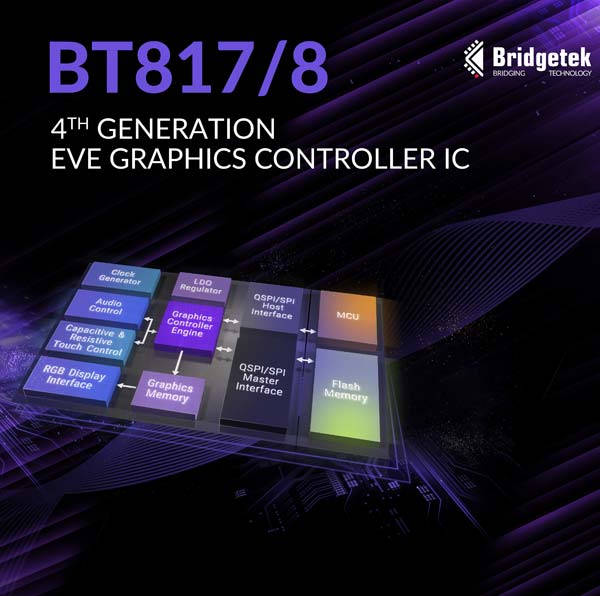 Driving forward the progression of human machine interface (HMI) development, Bridgetek has made further announcements relating to its multi-award winning embedded video engine (EVE) platform. The BT817 and BT818 represent the company’s fourth generation of EVE products, and follow the already established mantra of helping those with little or no relevant prior experience to build advanced HMIs with high degrees of differentiation.
Driving forward the progression of human machine interface (HMI) development, Bridgetek has made further announcements relating to its multi-award winning embedded video engine (EVE) platform. The BT817 and BT818 represent the company’s fourth generation of EVE products, and follow the already established mantra of helping those with little or no relevant prior experience to build advanced HMIs with high degrees of differentiation.
These new functionally-superior graphic controller ICs are intended for use in retail, digital signage and office management systems, as well as public information units, vending machines, domestic appliances, store/mall direction finding systems, training/educational equipment and interactive exhibits. They are able to address the requirements of HMIs rendered on much larger format displays and offer greater resolution levels too.
Suitable for use with 1Mpixel displays, the BT817 and BT818 support resolution numerous options – such as 1920×480, 1440×540, 1280×800, 1024×600, 800×600, 800×480, 480×272, etc. Each has a 1Mbyte embedded graphics RAM, and this can be supplemented by attaching an external NOR flash memory through the QSPI interface. Thanks to the object-oriented approach pioneered by EVE, there is no need for a frame buffer to be incorporated into the HMI system. In addition, by leveraging adaptive scalable texture compression (ASTC), it is possible to lower the system’s graphics processing overhead. This also means better use can be made of the available data storage capacity, so that bigger items can be accessed and more compelling HMI content delivered.
The BT818 is optimized for use with 4-wire resistive touchscreens, while the BT817 has been designed to accompany capacitive touchscreens (with multi-touch functionality allowing detection of up to 5 different touch points). Touch point movement can be accurately tracked and there is the scope to assign 255 different touch tags. The ability to adjust both the horizontal and vertical sync timing means that a much wider array of different display units can be accommodated. Power mode control ensures that electricity consumption is reigned in. Other notable features include video playback, enhanced sketch processing and a built-in sound synthesizer.
“EVE, and the unique object-based architecture that it relies upon, has already made a huge impact on the way that HMIs are now constructed, with the display, touch and audio aspects all being addressed via a single chip. It has streamlined the whole process and reduced the bill-of-materials costs involved significantly,” states Bridgetek’s founder and CEO Fred Dart. “Through the latest additions to this product family, we can assist our OEM partners in bringing touch interaction to a plethora of new applications where larger format displays are employed.”
The Bridgetek BT817 and BT818 are supplied in compact 9mm x 9mm 64-pin VQFN packages. An extended -40°C to 85°C operational temperature range allows them to be deployed within industrial environments.


